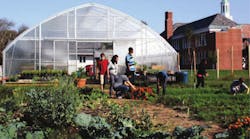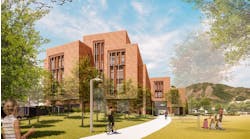Greenhouses are a wonderful tool for growing flowers and produce, but many education institutions are realizing that they have an additional benefit that can help children grow into well-rounded, health-conscious adults.
Using greenhouses as part of school curriculum is increasing in popularity, as people are becoming more curious about where their food comes from. By adding a greenhouse to school property, students will be able to get out of the classroom and into the fresh air to develop skills that will help them lead healthful, responsible lives.
Where Does Food Come From?
Today, people are realizing the significance of knowing where their food comes from and how it is produced. Adding a greenhouse to school grounds will instill this knowledge in children at a young age. Offering classes on growing and greenhouse management will help students learn how to produce their own food and give them an opportunity to get out of the classroom for some hands-on learning.
Plants are living organisms that need water, food and light to flourish, so students will gain a sense of responsibility; they will be the ones in charge of keeping the plants alive. From seed starting to harvesting, students can participate in every stage of the growth cycle. When children learn how to produce their own food, they are developing a strong work ethic, along with skills they can use for the rest of their lives.
Live Healthy for Life
Growing one's own food is not only fun, but healthy for people of all ages. Students will learn that fruits and vegetables may be delicious staples in their daily meals, while also developing the knowledge they need to produce it on their own. Fruits and vegetables that can be grown in a greenhouse offer crucial nutrients such as vitamin A, vitamin C and potassium, which help reduce the risk of developing chronic health issues later in life.
Fruits and vegetables as a part of every meal also will decrease the chance that students become obese. Obese children are more likely to suffer from health problems such as diabetes later in life, so maintaining a healthy weight at a young age is critical. Teaching healthful eating in school is a great way to ensure children understand the importance of a lifelong healthful diet.
Pick Your Own Lunch
Teaching students to grow is not the only benefit of greenhouse growing. By producing fresh fruits and vegetables at school, the cafeteria will be able to add this food to the menu.
It is recommended by the National Academy of Sciences' Institute of Medicine that children have two servings of fruit and vegetables per day, so having these healthy lunch options can help ensure that students' basic health requirements are met. Salad bars with an array of colorful vegetables can be added to the cafeteria inexpensively if almost all of the food is grown at school. Also, fresh fruits that normally are costly can be offered as side dishes more often, giving students a chance to grab a sweet treat that won't affect their health negatively. Adding an abundance of produce to the school lunch menu not only encourages students to make healthful choices when they get in line, but also may reduce funds spent buying food from other sources.
Sowing a Seed for the Future
Growing can become a way of life for students as they get older if they find they have a passion for it at a young age. Today, growing has become more than just a hobby for many people. Families have backyard gardens, or even small greenhouses to produce their own fresh produce. Many areas have community supported agriculture programs (CSAs) that provide local food to residents.
For kids who want growing to become a career, a variety of majors at colleges and universities enable students to focus on aspects of horticulture. Achieving a degree in horticulture can lead to a career in commercial growing, from owning a nursery or garden center to researching hydroponics and aquaponics. Enabling students to start a few seeds in a greenhouse when they are young could be the key to developing goals for the future.
A Greenhouse is Just the Beginning
The art of growing is changing constantly, and today, a variety of ways exist to grow items in and out of a greenhouse. Raised-bed gardening can be done inside a greenhouse or in the open air, and offers a controlled growing environment where the soil can be enhanced to meet the needs of specific crops. Raised beds can be used year after year with very little maintenance, and may be an attractive addition to the schoolyard. Hydroponic growing is becoming more popular, and it can be done in a small space with a system, water and nutrients. From Dutch buckets and ebb-and-flow systems to larger Nutrient Film Technique (NFT) channels, hydroponic systems in a greenhouse or classroom are a great way to get students involved with a more technologically advanced form of growing.
A school greenhouse may serve many purposes. Because of the open space greenhouses offer, they are ideal for holding large-group meetings and lectures. Greenhouses offer plenty of natural light, whether they are covered with polycarbonate or greenhouse film. This reduces the need for artificial lighting in other meeting spaces such as auditoriums or gymnasiums. Also, because most greenhouses are wired for electricity for fans and heaters, it is easy to hook up any equipment needed for meeting or lectures.
Teaching the next generation to grow with greenhouses and growing systems will enhance their lives and offer them a skill they can pass down to their children. Adding a greenhouse to school grounds will change the dynamic of any school. Students will be able to use their creative energies to grow healthful, fresh food and develop relationships with groups they may have had little in common with before growing began. Give students a place to grow, and they will have a gift to carry with them throughout life.
Davis is marketing assistant for Growers Supply, South Windsor, Conn., a manufacturer of greenhouses, high tunnels and hydroponic systems, offering design-build solutions for the horticulture industry. She can be reached at [email protected].
Related Video
Watch the video about greenhouses in schools:


